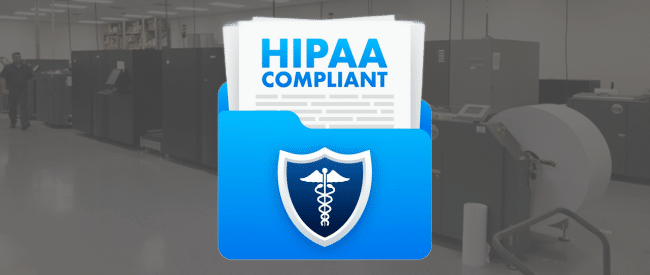Even as their efforts to repel cyberattacks become paramount, healthcare organizations cannot afford to relax their vigilance when it comes to HIPAA-compliant printing and mailing services. One big reason: 86% of patients receive printed medical billing statements sent in the mail, according to 2024 research by J.P. Morgan InstaMed.
Given this exposure, sticking to the status quo isn’t a viable strategy. New regulations and evolving threats continue shifting the goalposts on security and privacy best practices for HIPAA-compliant printing and mailing services.
Just this year, the U.S. government is finalizing the first major update to the Health Insurance Portability and Accountability Act since 2013. While a primary focus is on beefing up protections for electronic personal health information (ePHI), the new requirements would directly impact printing and mailing of patient financial and other communications.
The cost of noncompliance can be steep and long-lasting. HIPAA violations can result in fines of up to $1.5 million and criminal charges, depending on the circumstances, as well as lawsuits from patients whose data was stolen or exposed. Healthcare organizations with HIPAA violations also take a hit to their reputation and possibly their share price if they are publicly traded while they undermine the basis of effective clinical relationships—patient trust.
Defending against evolving threats and meeting changing regulations are proving increasingly costly and challenging for in-house printing operations. In contrast, HIPAA-compliant printing and mailing outsourcing leaders are investing in technology, training, protocols, and practices to consistently deliver the highest standards of compliance and data privacy and security, which are verified through third-party audits and certifications.
Successful HIPAA compliance, then, depends more than ever on partnering with companies that have proven expertise and experience in secure patient statement production and delivery. These experts keep pace with expanding regulations and stay ahead of emerging data security and privacy risks. Print and mail outsourcing drives additional benefits, too, including cost savings and streamlined workflows.
Keeping HIPAA-compliant printing and mailing services ahead of the curve
The prevalence of paper billing statements and other patient financial communications demands continuous attention and effective responses from print and mail companies to current and emerging vulnerabilities at each step of the production and mailing process. As AI builds its footprint in healthcare and other industries, print and mail companies need to regularly assess AI risks and threats and adapt their security measures.
At the same time, printing companies must cope with escalating regulation, which makes compliance more complex. While meeting HIPAA requirements is a prime focus, printing companies also must follow different and sometimes stricter patient data rules enacted by some states.
The pending HIPAA additional rules would further amp up compliance mandates for both providers of HIPAA-compliant printing and mailing services and their healthcare clients.
One proposed regulation, for instance, would make revenue cycle management companies, healthcare providers and accounts receivable management and collections firms responsible for more rigorous vendor oversight, including for print and mail outsourcers. Under the new rule, regulated entities would be required to formally evaluate the risks of entering into a HIPAA business associate agreement, with the assessment including receiving written security and privacy verifications from the business associate that have been validated by independent experts.
Download our white paper: Making Medical Bills a Higher Payment Priority for Consumers
Preparing for tougher HIPAA regs
In addition to stricter vendor oversight, Reuters reports that proposed requirements to the HIPAA Security Rule for covered entities include:
- Annual inventory of technology assets capable of creating, receiving, maintaining, or transmitting ePHI and a map of ePHI movement throughout the organization
- More thorough and detailed security assessments
- Multi-factor authentication with rare exceptions
- Mandatory encryption standards
- More formalized incident response plan and annual testing
- Business continuity/disaster recovery plans with more details and new deadlines for restoring systems and handling data backups and breach notifications
- Annual compliance audits
- Written and implemented procedures for workforce access to patient data
- Network testing, segmentation and configuration
Based on pending HHS updates, healthcare organizations and business partners would face additional new regulations under HIPAA’s Privacy and Omnibus rules.
Ensuring HIPAA-compliant printing and mailing services
In this dynamic regulatory and risk environment, revenue cycle, credit and collections leaders need to ensure their print and mail partners follow and continually update compliant best practices for safeguarding patient data. Top printing companies not only have developed robust, technology-enabled security and privacy measures, they follow them without fail. Best practices include:
1. Physical security.
Protecting patient data starts by limiting access to printing and mailing areas that handle patient communications and taking other measures such as:
- Use badge-controlled entries and 24/7 security cameras
- Place shields or other partitions to safeguard patient data from passersby
- Require employees to leave cell phones in their lockers
- Post signs stating no cell phones or cameras in printing and mailing area
- Restrict technology that could be used to obtain PHI and PII, such as blocking USB drives on the enterprise network.
2. Data and document handling.
The use of advanced encryption methods and secure servers and secure file transfer protocols (SFTP) protects patient information throughout the patient statement printing and mailing process. Other best-practice safeguards include:
- Transporting healthcare communications that have been printed and inserted in envelopes by closed carts to a secure area and shrink-wrapping the mailings before USPS pickup.
- Applying barcodes, using camera imaging and tracking patient documents at the job level and piece level to ensure the right statements are sent to the right patients.
- Enforcing strict methods for disposing of discarded communications with PHI and PII, which can result from paper jams, misprints and other misfires. These protocols can include in-house shredding or using a HIPAA-compliant service that does onsite destruction.
- Following strict procedures for handling return mail with patient data, such as using its own trucks to pick up undelivered healthcare mail from the post office and returning it to the secure facility for processing and disposal.
3. Regular HIPAA compliance and SOC 2 audits.
Printing companies should hire certified experts to conduct annual third-party audits to validate their HIPAA compliance. They also should adhere to and be audited annually against SOC 2 Type 2 standards, which attest to not just the design of the controls (which is the SOC 2 Type 1 standard) but their operating effectiveness directly related to security, availability, processing integrity, confidentiality, and privacy at a service organization.
4. Business continuity.
In case of natural disaster or other disruption, printing companies should have redundant facilities, geographically apart, that are set up for HIPAA-compliant printing and mailing services.
5. Employee training.
Creating strict policies for HIPAA-compliant printing and mailing services is only useful if they are followed for every healthcare client and job. HIPAA print and mail specialists provide ongoing training on HIPAA and PHI/PII for all employees and all new hires–not just print production and mailing services staff.
Skilled employees play a vital role in overseeing high-end equipment and software and automated workflows. Depending on the run type, Operators should inspect and validate a job every 2,500 pieces, for example. They also should inspect envelope windows, if used, to confirm no PHI or PII is visible. And if there is a problem with matching patient statements to envelopes, the inserting system automatically shuts down and a supervisor intervenes to resolve the misalignment and restart the inserter to finish the job.
Leveraging omnichannel HIPAA-compliant solutions
For greater strategic impact beyond HIPAA compliance, revenue cycle management firms, credit and collections companies and providers should consider partnering with a HIPAA-compliant printing and mailing services firm that also offers HIPAA-compliant digital communications and payment options. After all, many patients are interested in electronic statements, text reminders and online payments, sometimes in addition to mailed statements.
A cloud omnichannel customer communications management platform for creating print and digital healthcare communications offers the necessary versatility and efficiency to meet the diverse preferences. It also simplifies the complexity of managing different delivery channels and communications types, from mail to mobile, by consolidating them all on a single platform. The outcome: Improved patient financial experience and engagement that drives more on-time payments.
To discuss HIPAA-compliant patient statement printing and mailing and HIPAA-compliant digital solutions, please contact us.







